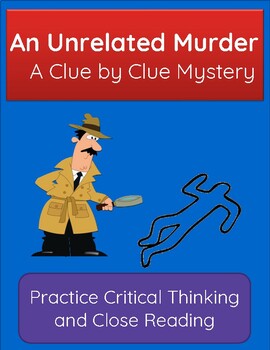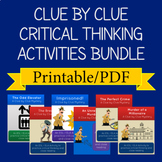An Unrelated Murder: Critical Thinking Mystery Printable Activity
- PDF
Also included in
- By popular demand, all my clue by clue mysteries PDF (printable) format in one big bundle, plus a free mystery story organizing worksheet. Be sure to check the list above to see the exact list of Clue by Clue Mysteries!Each individual mystery is in PDF format and contains:A cover imageComprehensivePrice $90.00Original Price $123.00Save $33.00
Description
In this engaging mystery activity that gets students using their critical thinking, skills, students have to guess why a man murdered a woman when police can't find any connection between them. Can your students think logically and use reading strategies to follow the clues and find the motive for the mysterious murder!
This is a printable PDF edition designed to be used in the classroom for pair work or in small groups. However, it can also be adapted for individual work or worked through with the whole class. Designed for middle grade or high school students, this activity has also been used with college and university students, or even young adults.
I have separate listings for other formats:
Click here for the mystery in PowerPoint Presentation and Click here to get it as a Google Slides presentation.
What is a Clue by Clue Mystery?
It's a great warm-up, filler, or time killer for early finishers. Students are given a mystery to solve--whodunit or how did they do it or why. They have to figure it out by reading a series of clues, one at a time. As they receive each clue, they speculate on its significance and what it tells them about the situation.
Once they have received all the clues, they should have enough information to figure it out!
Clue by Clues make great warm-up activities, fillers, or time killers for those last minutes of class and early finishers. They can be critical thinking and close reading activities that teach students to look for details, synthesize information from different sources, apply prior knowledge about the world, and to recognize the logic of a claim and evaluate its validity.
Inside find:
- Teacher Notes on how to use the clues, including suggested warm-ups.
- 8 clues to be given to students one by one.
- Hints in the form of guiding questions to help students figure out what happened.
- The Solution: Students are not left hanging. There is a clear solution that follows from the clues.
- Discussion Questions (optional) to extend the activity, asking about movies or stories with similar plots and ways to commit the "perfect" murder.
While students are solving the mysteries they are also developing their spoken language skills, using language such as:
* Modal verbs of speculation: She must have forgotten her keys, It could have been the butler
* Opinion language: I think...., I’m positive..., I’m not sure...
* Hedging: It’s possible, probably, maybe, it’s not impossible.
* Conclusions: That means that...
* Emphasis: There’s no way that...
* Hypotheticals: What if he didn’t do it, If he was at the movies, he couldn’t have done it.
They are also a lot of fun!
Enjoy this? Check out my entire Mystery Section with more clue by clues in different formats. I also have activities to help students write their own mysteries and more!
And please leave a review. It helps others find this resource and gives me valuable feedback when creating new ones!






